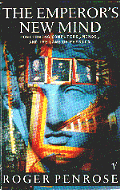 |
Chapter 3:Mathematics and Reality |
Platonic Reality of Mathematical Concepts
How "real" are the objects of a mathematician's world? From one point of view it seems there can be nothing real about them at all.Mathematical objects are just concepts;they are the mental idealizations that mathematicians make,often stimulated by the appearance and seeming order of aspects of the world about us,but mental idealizations nevertheless. Can they be other than mere arbitrary constructions of the human mind? At the same time there often does appear to be some profound reality about these mathematical concepts,going quite beyond the mental deliberations of any particular mathematician.It is as though human thought is,instead,being guided towards some external truth - a truth which has a reality of its own,and is revealed only partially to any one of us.
The Mandelbrot set provides a striking example.Its wonderfully elaborate structure was not the invention of any one person,nor was it the design of a team of mathematicians.Benoit Mandelbrot himself,the Polish-American mathematician (and protagonist of fractal theory) who first studied the set,had no real prior conception of the fantastic elaboration inherent in it,although he knew he was on the track of something very interesting.
[There is actually some dispute concerning who it was that first came
across this set (see Brooks and Matelski 1981,Mandelbrot 1989);but the very
fact that there can be such a dispute lends further support for the
view that the finding of this set was more like a discovery than an
invention]

A Julia Set,a sub ordinate of the Mandelbrot set,generated from the same formula.
Indeed,when his first computer pictures began to emerge,he was under the impression that the fuzzy structures that he was seeing were the result of a computer malfunction (Mandelbrot 1986)! Only later did he become convinced that they were really there in the set itself.Moreover,the complete details of the complication of the structure of Mandelbrot's set cannot be really fully comprehended by any one of us,nor can it be fully revealed by any computer [Ref: Predictions Jul 97,p8 "Fract or Friction"].It would seem that this structure is not just part of our minds,but it has a reality of its own.Whichever mathematician or computer buff chooses to examine the set,approximations to the same fundamental mathematical structure will be found.It makes no real difference which computer is used for performing calculations (provided that the computer is in accurate working order),apart from the fact that differences in computer speed and storage,and graphic display capabilities,any lead to differences in the amount of fine detail that will be revealed and in the speed with which that detail is produced.The computer is being used in essentially the same way that an experimental physicist uses a piece of experimental apparatus to explore the structure of the physical world.The Mandelbrot set is not an invention of the human mind:it was a discovery.Like Mount Everest,the Mandelbrot set is just there!
Likewise,the very system of complex numbers has a profound and timeless reality which goes quite beyond the mental construction of any particular mathematician.The beginnings of an appreciation of complex numbers came about with the work of Gerolamo Cardano.He was an Italian,who lived from 1501 to 1576,a physician by trade,a gambler, and a caster of horoscopes (once casting a horoscope for Christ),and he wrote and important and influential treatise on algebra "Ars Magna" in 1545.In this he put forward the first complete expression for the solution (in terms of surds,ie nth roots) of a general cubic equation (based partly on earlier work by Sciopone del Ferro and by Tartaglia).He had noticed,however,that in certain class of cases - the ones referred to as "irreducible", where the equation has three real solutions - he was forced to take,at a certain stage in his expression,the square root of a negative number.Although this was puzzling to him,he realized that if he allowed himself to take such square roots,and only if,then he could express the full answer (the final answer being always real).Later,in 1572,Raphael Bombelli,in a work entitled "l'Algebra",extended Cardano's work and began the study of the actual algebra of complex numbers.
While at first it may seem that the introduction of such square roots of negative numbers is just a device - a mathematical invention designed to achieve a specific purpose - it later becomes clear that these objects are achieving far more than that for which they were originally designed.As I mentioned above,although the original purpose of introducing complex numbers was to enable square roots to be taken with impunity,by introducing such numbers we find that we get,as a bonus,the potentiality for taking any other kind of root or for solving any algebraic equation whatever.Later we find many other magical properties that these complex numbers possess,properties that we had no inkling about at first.These properties are just there.They were not put there by Cardano,nor by Bombelli,nor Wallis,nor Coates,nor Ruler,nor Wessel,nor Gauss,despite the undoubted farsightedness of these,and other,great mathematicians;such magic was inherent in the very structure that they gradually uncovered.When Cardano introduced his complex numbers,he could have no inkling of the many magical properties which were to follow - properties which go under various names,such as the Cauchy integral formula,the Riemann mapping theorem,the Lewy extension property.These,and many other remarkable facts,are the properties of the very numbers,with no additional modifications whatever,that Cardano had first encountered in about 1539.
Is mathematics invention or discovery? When mathematicians come upon their results are they just producing elaborate mental constructions that have no actual reality,but whose power and elegance is sufficient to simply fool even their inventors into believing that these mere mental constructions are "real"? Or are mathematicians really uncovering truths which are,in fact,already "there" - truths whose existence is quite independent of the mathematicians' activities? I think that,by now,it must be quite clear to the reader that I am an adherent to the second,rather than the first,view,at least with regard to such structures as complex numbers and the Mandelbrot set.
Yet the matter is perhaps not quite so straightforward as this.As I have said,there are things in mathematics for which the term "discovery" is indeed much more appropriate than "invention",such as the examples just cited.These are the cases where much more comes out of the structure than was put in it in the first place [You mean you get something from nothing Roger? -LB].One may take the view that in such cases the mathematicians have stumbled upon the "works of God".However,there are some cases where the mathematical structure does not have such a compelling uniqueness,such as when,in the midst of a proof of some result,the mathematician finds the need to introduce some contrived and far from unique construction in order to achieve some very specific end.In such cases no more is likely to come out of the construction than was put into it in the first place,and the word "invention" seems more appropriate than "discovery".These are indeed just "works of man".On this view,the true mathematical discoveries would,in a general way,be regarded as greater achievements or aspirations than would the "mere" inventions.
Such categorizations are not entirely dissimilar from those that one might use in the arts or in engineering. Great works of art are indeed "closer to God" than are lesser ones.It is a feeling not uncommon among artists,that in their greatest works they are revealing eternal truths which have some kind of prior ethereal existence,while their lesser works might be more arbitrary,of the nature of mere mortal constructions.
[As the distinguished Argentinian writer Jorge Luis Borges has put it:"....a famous poet is less of an inventor than a discoverer....."]
Likewise,an engineering innovation with a beautiful economy,where a great deal is achieved in the scope of the application of some simple,unexpected idea, might appropriately be described as a discovery rather than an invention.
Having made these points,however,I cannot help feeling that,with mathematics,the case for believing in some kind of ethereal,eternal existence,at least for the more profound mathematical concepts,is a good deal stronger than in those other cases.There is a compelling uniqueness and universality in such mathematical ideas which seems to be of quite a different order from that which one could expect in the arts or or engineering.The view that mathematical concepts could exist in such a timeless,ethereal sense was put forward in ancient times (c.360 BC) by the great Greek philosopher Plato.Consequently,this view is frequently referred to as mathematical Platonism [Ref: Davis & Hersh "The Mathematical Experience" {Platonism}].It will have considerable importance for us later.
In Ch1,I discussed at some length the point of view of strong AI,according to which mental phenomena are supposed to find their existence within the mathematical idea of an algorithm.In Ch2,I stressed the point that the concept of an algorithm is indeed a profound and "God given" notion.In this chapter I have been arguing that such "God given" mathematical ideas should have some kind of timeless existence, independent of our earthly selves.Does this viewpoint lend some credence to the strong-AI point of view,by providing the possibility of an ethereal type of existence for mental phenomena? Just conceivably so - and I shall even be speculating,later,in favour of a view not altogether dissimilar from this;but if mental phenomena can indeed find a home of this general kind,I do not believe that it can be with the concept of an algorithm.What would be needed would be something very much more subtle.The fact that algorithmic things constitute a very narrow and limited part of mathematics will be an important aspect of the discussions to follow.We shall begin to see something of the scope and subtlety of non-algorithmic mathematics in the next chapter.
